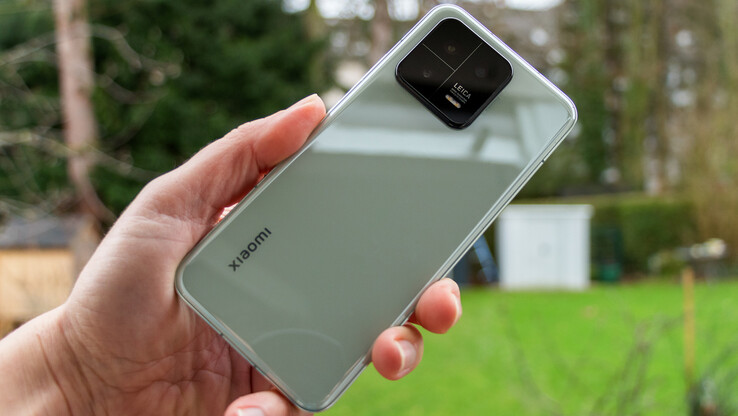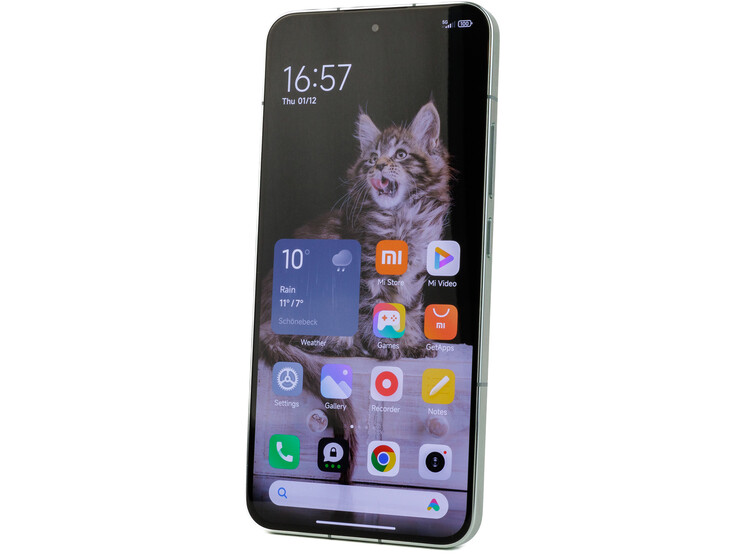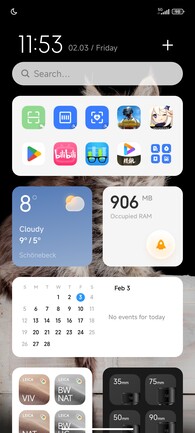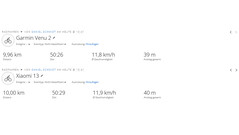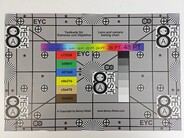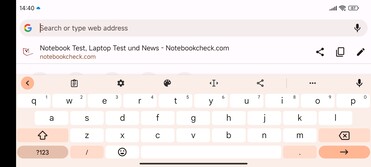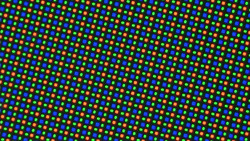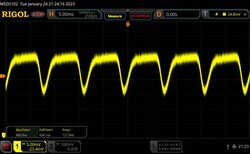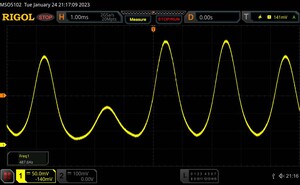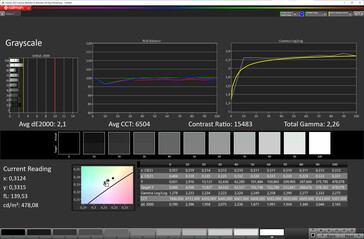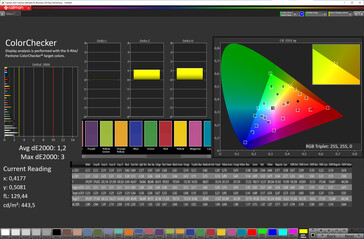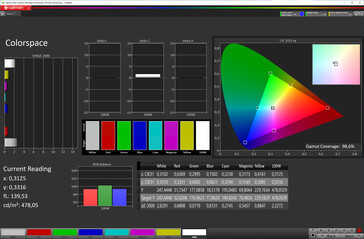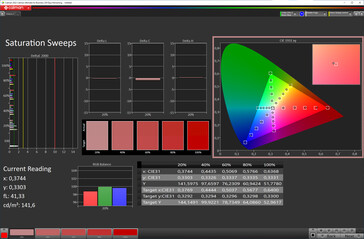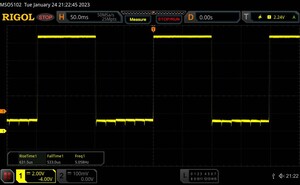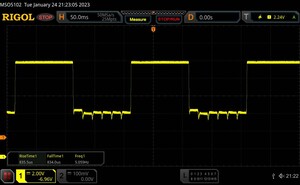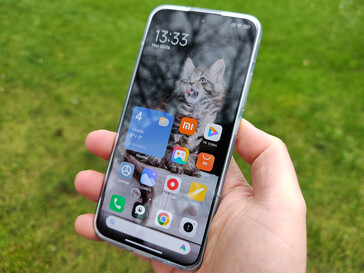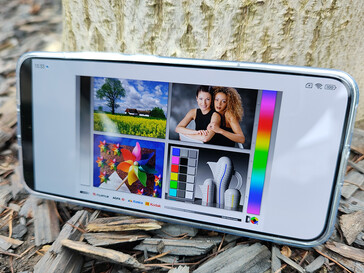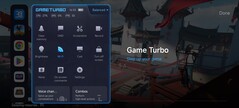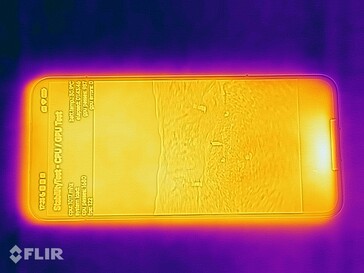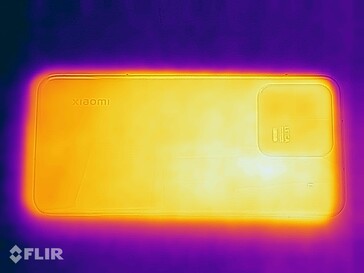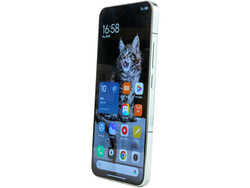小米13评测--配备徕卡相机的紧凑型动力设备
小米13是继去年的 小米12并保持了该系列的特点,是一款紧凑的高端智能手机。小米13的显示屏只是稍大一些。正如预期的那样,这款手机再次采用了高通公司的最新旗舰SoC--这次是 骁龙8代2.
虽然该设备与前代产品有很多相同的规格,但小米对相机设置进行了彻底改造。我们指的不仅仅是与徕卡的合作,还包括传感器。除了有一个新的主传感器,相机模块现在配备了一个光学变焦镜头,而不是一个专门的微距镜头。
我们的评论单元是来自中国的进口版本。小米13的国际版预计将在3月到来(,见我们的新闻报道 ,德语),据说价格为999欧元(1073美元)。如果你决定购买进口机型,可以从零售商那里以低于800欧元(860美元)的价格买到这款手机。
潜在的竞争对手比较
Rating | Date | Model | Weight | Drive | Size | Resolution | Price |
|---|---|---|---|---|---|---|---|
| 89.1 % v7 (old) | 02 / 2023 | Xiaomi 13 SD 8 Gen 2, Adreno 740 | 189 g | 256 GB UFS 4.0 Flash | 6.36" | 2400x1080 | |
| 89.3 % v7 (old) | 05 / 2022 | Samsung Galaxy S22 Exynos 2200, Xclipse 920 | 167 g | 128 GB UFS 3.1 Flash | 6.10" | 2340x1080 | |
| 89.3 % v7 (old) | 10 / 2022 | Motorola Edge 30 Ultra SD 8+ Gen 1, Adreno 730 | 198.5 g | 256 GB UFS 3.1 Flash | 6.67" | 2400x1080 | |
| 89.1 % v7 (old) | 11 / 2022 | Google Pixel 7 Pro Tensor G2, Mali-G710 MP7 | 212 g | 128 GB UFS 3.1 Flash | 6.70" | 3120x1440 | |
| 89.2 % v7 (old) | 04 / 2022 | Oppo Find X5 Pro SD 8 Gen 1, Adreno 730 | 221 g | 256 GB UFS 3.1 Flash | 6.70" | 3216x1440 | |
| 90.3 % v7 (old) | 01 / 2023 | Apple iPhone 14 Pro A16, A16 GPU 5-Core | 206 g | 256 GB NVMe | 6.10" | 2556x1179 |
外壳 - 玻璃和铝制设计,手感极佳
» Notebookcheck多媒体笔记本电脑Top 10排名
» Notebookcheck游戏笔记本电脑Top 10排名
» Notebookcheck低价办公/商务笔记本电脑Top 10排名
» Notebookcheck高端办公/商务笔记本电脑Top 10排名
» Notebookcheck工作站笔记本电脑Top 10排名
» Notebookcheck亚笔记本电脑Top 10排名
» Notebookcheck超级本产品Top 10排名
» Notebookcheck变形本产品Top 10排名
» Notebookcheck平板电脑Top 10排名
» Notebookcheck智能手机Top 10排名
» Notebookcheck评测过最出色的笔记本电脑屏幕
» Notebookcheck售价500欧元以下笔记本电脑Top 10排名
» Notebookcheck售价300欧元以下笔记本电脑Top 10排名
小米13在中国市场上有多种颜色可供选择:黑色、白色、蓝色(褶皱表面)和玉绿色,这是我们评测机的颜色。在中国,该公司还提供火焰红、宝石蓝、飓风黄、丛林绿和水泥灰等限量版机型。
手机的正面和背面由康宁大猩猩玻璃Victus保护,触感良好,但它们是真正的指纹磁铁。光滑的抛光铝框也是如此。该设备的结构非常好,底盘上的所有缝隙都很紧密和均匀。SIM卡槽的盖子是由与框架相同的材料制成的,并与框架形成一个整体,看起来和感觉都很干净。
从设计上看,相机模块现在与其他小米手机上的相机模块进一步区分开来,并在背面突出显示,从机身伸出相当大的2.25毫米(0.09英寸)。小米13具有IP68等级,这意味着它具有防水和防尘的功能。
规格 - 仍然只支持USB 2.0
与前代产品一样,小米13配备了一个USB-C接口,不支持通过电缆输出视频。但至少它能够进行OTG,从而使用户能够连接外部外围设备和存储设备。不幸的是,该接口只支持USB 2.0,在我们的测试中,它的传输速度只有37.7 MB/s。
这款手机也没有音频插孔或microSD插槽。作为回报,你会得到一个红外发射器,可以让你远程控制多媒体设备、空调和相机等东西。小米13也有蓝牙5.3,NFC和UWB功能(用于将设备变成数字汽车钥匙)。
在中国,这款旗舰手机有四种内存/存储配置:8/128GB、8/256GB、12/256GB和12/512GB。根据经验,国际版的选择可能会更少。
软件 - 小米13搭载了Android 13和MIUI 14
小米13的出货量为目前的Android 13。我们从中国进口的版本预装了许多中国应用程序。我们的评测设备上缺少谷歌应用商店,但这可以在事后使用APK轻松补救。但是,如果你从TradingShenzhen(他好心借给我们评测设备)购买手机,Google Play Store将预装在设备上。
这款手机已经有基本的谷歌服务,但Android Auto在进口版本上不工作,它只支持以下系统语言。中文、藏语、维吾尔语和英语--这一点我们已经在Mix Fold 2上看到过了。 混合折叠2.在小米13上应该可以观看受DRM保护的高清内容,因为该设备有Widevine L1认证。
在这次审查时,安全补丁最后一次更新是在2022年12月1日,因此不是非常最新的。现在,小米还没有宣布该设备将获得多少年的更新。尽管小米很可能计划为该手机提供三个Android 更新和四年的安全补丁(每季度推出)。更多信息肯定会在全球发布期间公布。
连接性和全球导航卫星系统 - 在6GHz频段的卓越性能
小米13能够使用快速的Wi-Fi 6E访问本地数据网络,因此可以利用6GHz频段。与我们的参考路由器(华硕ROG Rapture GT-AXE11000)配对,该手机不仅提供了极高的传输速度,还保持了非常稳定的连接。在5GHz频段,小米设备成功地产生了类似的巨大性能,只有在传输数据时才会放慢速度。从纸面上看,小米13目前也支持Wi-Fi 7,但我们无法测试,因为我们手头没有合适的路由器。
我们进口设备上的移动频段是为亚洲市场定制的。这在欧洲对6以下的5G不构成任何问题,因为所有必要的频段都支持。而LTE的情况则不同。缺乏对20号频段(800MHz)的支持尤其值得指出,因为它被服务提供商用于大范围的覆盖。因此,在城市地区和大城市,你可能不会注意到这一点,但在更多的农村地区以及高速公路上,这肯定会成为一个问题。
这种限制并不适用于国际版,因为根据经验,它可能会支持更广泛的移动频段。
电话和语音质量
相机 - 与徕卡合作的三相机设置
前置摄像头与小米12的摄像头非常相似。它再次拥有高达3200万像素的分辨率,但配备了一个更宽的f/2.0光圈。前置摄像头在视频能力方面是一个倒退。它能够录制高达全高清的视频,但速度只有30帧。相比之下, 小米12能以60帧/秒的速度拍摄全高清视频。该相机在光线良好的情况下能产生令人愉快的图像质量。而且,由于传感器不使用像素分档,照片可以获得全分辨率。
小米一直在吹捧与徕卡公司联合开发的三摄像头阵列,作为该手机的亮点之一。主摄像头采用索尼IMX800传感器,有5400万像素(其中5000万像素是有效可用的),并带有徕卡Vario-Summicron 1:18-2.2/15-75 ASPH标签。你还会发现一个超宽相机和一个3.2倍光学变焦的长焦镜头。与徕卡的合作似乎不仅仅是软件,还包括镜头上的ALD涂层,旨在提高其质量。徕卡在软件中提供两种模式:鲜艳和真实。前者使颜色看起来更明亮、更饱和,而后者是为了复制原始的徕卡外观,允许生动的光线和饱和的阴影。我们所有的测试照片都是在真实模式下拍摄的。
使用主相机拍摄的图像以非常高的对比度和高度的细节而引人注目。这种反差水平使照片看起来略微太暗。超广角相机有一个体面的景深,但图像在边缘处明显变得不那么清晰。黑暗区域也表现出可感知的噪音。变焦相机提供合理的图像质量,甚至在5倍变焦时也是如此。然而,轮廓在后期被非常严重地锐化,从而导致主体看起来非常不自然。
后置摄像头阵列可以录制高达60帧/秒的超高清视频或24帧/秒的8K视频。后者的选择最终是相当平均的,因为8K视频的黑暗区域有明显的噪音。
缩放图像(从左)。 3.2倍、5倍、10倍和30倍变焦
Image comparison
Choose a scene and navigate within the first image. One click changes the position on touchscreens. One click on the zoomed-in image opens the original in a new window. The first image shows the scaled photograph of the test device.
HauptkameraHauptkameraUltraweitwinkel5-facher ZoomLow-Light在受控的照明条件下,主摄像头在照片的中心位置非常详细地再现了我们的测试图表。图像在边缘处失去了一点锐度和对比度,但这种损失并不过分。
尽管有徕卡真实模式,但该相机系统与小米12的相机非常相似。 小米12在色彩再现方面非常相似。三角洲E值已得到小幅改善,但特别是绿色阴影仍然与它们在现实生活中的样子有很大偏差。
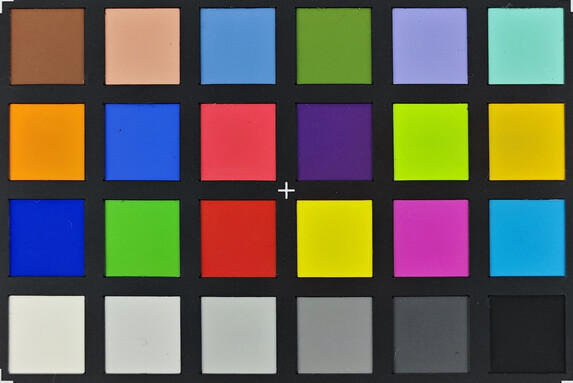

配件和保修 - 仅有12个月的保修期
小米13配备了一个带有USB-A端口的模块化67瓦电源适配器。如果你决定使用进口设备,你会收到一个与A型电插头兼容的型号。然而,借给我们设备的TradingShenzhen公司已经包括一个适当的适配器。盒子里还有一条相应的USB线(A型到C型),一个SIM卡弹出工具和一个透明的硅胶套。
不幸的是,小米只提供了12个月的保修。但你的保修权利不受影响(如适用)。
输入设备和操作 - 光学指纹扫描仪
显示屏 - 超亮的AMOLED,能够达到120Hz。
小米13的显示屏尺寸为6.36英寸(16.15厘米),具有全高清分辨率--相当于400PPI的像素密度。这款智能手机还支持所有现代HDR标准,包括HDR10+和Dolby Vision。然而,不那么最新的是屏幕的自适应刷新率,它只能在60、90和120Hz之间动态切换。
启用环境光传感器后,在显示全白图像时,屏幕的峰值亮度为1217cd/m²,这比前代产品(最大875cd/m²)有了大幅提升。虽然小米承诺本地峰值亮度为1900尼特,但我们在评测单元中只得到了1756cd/m²(APL18)的最高亮度。尽管如此,仍然是一个优秀的结果。如果你喜欢手动调整屏幕亮度,你将有高达506 cd/m²的亮度供你使用。
与大多数采用OLED面板的智能手机一样,小米13有闪烁的问题。在最低亮度下,显示屏以相当粗糙的162至488Hz闪烁。随着亮度的增加,波形变得更加平滑。在超过65%的亮度水平下,我们只能检测到相当于刷新率的闪烁。因此,如果你对使用脉冲波调制敏感,你应该启用直流调光选项(防闪烁模式)。一旦它被激活,我们只能在整个亮度范围内检测到相当于刷新率的闪烁。
| |||||||||||||||||||||||||
Brightness Distribution: 98 %
Center on Battery: 1209 cd/m²
Contrast: ∞:1 (Black: 0 cd/m²)
ΔE ColorChecker Calman: 1.2 | ∀{0.5-29.43 Ø4.78}
ΔE Greyscale Calman: 2.1 | ∀{0.09-98 Ø5}
98.6% sRGB (Calman 2D)
Gamma: 2.26
CCT: 6504 K
| Xiaomi 13 OLED, 2400x1080, 6.4" | Samsung Galaxy S22 AMOLED, 2340x1080, 6.1" | Motorola Edge 30 Ultra pOLED, 2400x1080, 6.7" | Google Pixel 7 Pro OLED, 3120x1440, 6.7" | Oppo Find X5 Pro AMOLED, 3216x1440, 6.7" | Apple iPhone 14 Pro Super Retina XDR OLED, 2556x1179, 6.1" | Xiaomi 12 OLED, 2400x1080, 6.3" | |
|---|---|---|---|---|---|---|---|
| Screen | -19% | -2% | 12% | 3% | -2% | -22% | |
| Brightness middle (cd/m²) | 1209 | 853 -29% | 1020 -16% | 1022 -15% | 746 -38% | 1046 -13% | 867 -28% |
| Brightness (cd/m²) | 1208 | 858 -29% | 1020 -16% | 1025 -15% | 744 -38% | 1049 -13% | 867 -28% |
| Brightness Distribution (%) | 98 | 96 -2% | 96 -2% | 99 1% | 97 -1% | 98 0% | 98 0% |
| Black Level * (cd/m²) | |||||||
| Colorchecker dE 2000 * | 1.2 | 1.9 -58% | 1 17% | 0.9 25% | 0.9 25% | 1.2 -0% | 1.7 -42% |
| Colorchecker dE 2000 max. * | 3 | 3.2 -7% | 2.8 7% | 2.1 30% | 1.6 47% | 3.1 -3% | 4.4 -47% |
| Greyscale dE 2000 * | 2.1 | 1.9 10% | 2.1 -0% | 1.1 48% | 1.6 24% | 1.7 19% | 1.8 14% |
| Gamma | 2.26 97% | 2.07 106% | 2.29 96% | 2.22 99% | 2.23 99% | 2.19 100% | 2.2 100% |
| CCT | 6504 100% | 6460 101% | 6502 100% | 6650 98% | 6499 100% | 6538 99% | 6762 96% |
* ... smaller is better
Screen Flickering / PWM (Pulse-Width Modulation)
| Screen flickering / PWM detected | 488 Hz | ||
The display backlight flickers at 488 Hz (worst case, e.g., utilizing PWM) . The frequency of 488 Hz is relatively high, so most users sensitive to PWM should not notice any flickering. However, there are reports that some users are still sensitive to PWM at 500 Hz and above, so be aware. In comparison: 53 % of all tested devices do not use PWM to dim the display. If PWM was detected, an average of 8111 (minimum: 5 - maximum: 343500) Hz was measured. | |||
Display Response Times
| ↔ Response Time Black to White | ||
|---|---|---|
| 1.16 ms ... rise ↗ and fall ↘ combined | ↗ 0.6315 ms rise | |
| ↘ 0.533 ms fall | ||
| The screen shows very fast response rates in our tests and should be very well suited for fast-paced gaming. In comparison, all tested devices range from 0.1 (minimum) to 240 (maximum) ms. » 5 % of all devices are better. This means that the measured response time is better than the average of all tested devices (20.2 ms). | ||
| ↔ Response Time 50% Grey to 80% Grey | ||
| 1.67 ms ... rise ↗ and fall ↘ combined | ↗ 0.8355 ms rise | |
| ↘ 0.834 ms fall | ||
| The screen shows very fast response rates in our tests and should be very well suited for fast-paced gaming. In comparison, all tested devices range from 0.165 (minimum) to 636 (maximum) ms. » 7 % of all devices are better. This means that the measured response time is better than the average of all tested devices (31.6 ms). | ||
性能--小米13中的Snapdragon 8 Gen 2
小米13采用了高通公司制造的最新的Snapdragon 8 Gen 2 ,在我们的评测单元中,它的两侧是8GB的LPDDR5x内存。这款高端SoC总共由四个集群组成。第一个有一个单一的Prime核心,可以在3.2GHz的频率下运行。两个性能集群分别有两个Cortex A715内核和两个Cortex A710内核(每个都能达到2.8GHz),而最后一个集群有三个Cortex A510内核,用于高效率地运行任务。
就纯粹的CPU速度而言,该设备比小米12 (Snapdragon 8 Gen 1)有了飞跃性的进步。它在Geekbench单核测试中得分高出19%,在多核测试中领先优势扩大到42%。更重要的是,该SoC甚至比骁龙8+ Gen 1 (+11%/+20%)显示出巨大的性能提升。
这款手机不仅在日常使用中表现出色,而且我们在基准测试中也找不到它的任何缺点。尽管小米13在Basemark OS II中落后于摩托罗拉Edge 30 Ultra ,但它在AnTuTu中以较大的优势击败了Motorala手机。
评估该手机的人工智能性能并不是一件容易的事。AIMark没有在小米13上运行。在Procyon中,该设备只比Edge 30 Ultra略快。该 像素7 Pro和 iPhone 14 Pro在Geekbench ML中完全击败了小米。但这也可能是由于驱动优化不佳。即将发布的对搭载骁龙8代的智能手机的评测将为这个话题带来更多启示。
| UL Procyon AI Inference for Android - Overall Score NNAPI | |
| Oppo Find X5 Pro | |
| Google Pixel 7 Pro | |
| Average of class Smartphone (3769 - 81594, n=139, last 2 years) | |
| Xiaomi 13 | |
| Average Qualcomm Snapdragon 8 Gen 2 (11338 - 16880, n=21) | |
| Motorola Edge 30 Ultra | |
| Geekbench ML | |
| 0.5 TensorFlow Lite CPU 0.5 | |
| Apple iPhone 14 Pro | |
| Xiaomi 13 | |
| Average Qualcomm Snapdragon 8 Gen 2 (547 - 608, n=3) | |
| Motorola Edge 30 Ultra | |
| Google Pixel 7 Pro | |
| Oppo Find X5 Pro | |
| 0.5 TensorFlow Lite GPU | |
| Apple iPhone 14 Pro | |
| Motorola Edge 30 Ultra | |
| Average Qualcomm Snapdragon 8 Gen 2 (1833 - 2202, n=3) | |
| Xiaomi 13 | |
| Oppo Find X5 Pro | |
| Google Pixel 7 Pro | |
| 0.5 TensorFlow Lite NNAPI / Core ML | |
| Apple iPhone 14 Pro | |
| Google Pixel 7 Pro | |
| Motorola Edge 30 Ultra | |
| Xiaomi 13 | |
| Average Qualcomm Snapdragon 8 Gen 2 (401 - 633, n=3) | |
| Oppo Find X5 Pro | |
ǞǞǞ阿德雷诺740集成在SoC中,负责图形处理。该GPU的性能有点儿参差不齐。在使用OpenGL ES API的旧基准测试中,新GPU有时比 Adreno 730但这同样也可能是由驱动问题造成的。一旦使用Vulkan API,我们看到了高达34%的性能提升,小米13的性能甚至超过了当前一代的 iPhone.
GFXBench (DX / GLBenchmark) 2.7: T-Rex Onscreen | 1920x1080 T-Rex Offscreen
GFXBench 3.0: on screen Manhattan Onscreen OGL | 1920x1080 1080p Manhattan Offscreen
GFXBench 3.1: on screen Manhattan ES 3.1 Onscreen | 1920x1080 Manhattan ES 3.1 Offscreen
GFXBench: on screen Car Chase Onscreen | 1920x1080 Car Chase Offscreen | on screen Aztec Ruins High Tier Onscreen | 2560x1440 Aztec Ruins High Tier Offscreen | on screen Aztec Ruins Normal Tier Onscreen | 1920x1080 Aztec Ruins Normal Tier Offscreen | 3840x2160 4K Aztec Ruins High Tier Offscreen
| 3DMark / Wild Life Extreme Unlimited | |
| Xiaomi 13 | |
| Apple iPhone 14 Pro | |
| Motorola Edge 30 Ultra | |
| Oppo Find X5 Pro | |
| Xiaomi 12 | |
| Samsung Galaxy S22 | |
| Google Pixel 7 Pro | |
| 3DMark / Wild Life Extreme | |
| Xiaomi 13 | |
| Apple iPhone 14 Pro | |
| Motorola Edge 30 Ultra | |
| Xiaomi 12 | |
| Oppo Find X5 Pro | |
| Samsung Galaxy S22 | |
| Google Pixel 7 Pro | |
| 3DMark / Wild Life Unlimited Score | |
| Xiaomi 13 | |
| Apple iPhone 14 Pro | |
| Motorola Edge 30 Ultra | |
| Oppo Find X5 Pro | |
| Xiaomi 12 | |
| Samsung Galaxy S22 | |
| Google Pixel 7 Pro | |
| 3DMark / Sling Shot Extreme (ES 3.1) Unlimited Physics | |
| Motorola Edge 30 Ultra | |
| Google Pixel 7 Pro | |
| Xiaomi 12 | |
| Xiaomi 13 | |
| Samsung Galaxy S22 | |
| Oppo Find X5 Pro | |
| 3DMark / Sling Shot Extreme (ES 3.1) Unlimited Graphics | |
| Xiaomi 13 | |
| Motorola Edge 30 Ultra | |
| Xiaomi 12 | |
| Oppo Find X5 Pro | |
| Samsung Galaxy S22 | |
| Google Pixel 7 Pro | |
| 3DMark / Sling Shot Extreme (ES 3.1) Unlimited | |
| Motorola Edge 30 Ultra | |
| Xiaomi 13 | |
| Xiaomi 12 | |
| Oppo Find X5 Pro | |
| Google Pixel 7 Pro | |
| Samsung Galaxy S22 | |
| GFXBench (DX / GLBenchmark) 2.7 / T-Rex Onscreen | |
| Motorola Edge 30 Ultra | |
| Xiaomi 12 | |
| Google Pixel 7 Pro | |
| Xiaomi 13 | |
| Samsung Galaxy S22 | |
| Oppo Find X5 Pro | |
| Apple iPhone 14 Pro | |
| GFXBench (DX / GLBenchmark) 2.7 / T-Rex Offscreen | |
| Apple iPhone 14 Pro | |
| Motorola Edge 30 Ultra | |
| Xiaomi 12 | |
| Xiaomi 13 | |
| Oppo Find X5 Pro | |
| Samsung Galaxy S22 | |
| Google Pixel 7 Pro | |
| GFXBench 3.0 / Manhattan Onscreen OGL | |
| Motorola Edge 30 Ultra | |
| Xiaomi 12 | |
| Xiaomi 13 | |
| Samsung Galaxy S22 | |
| Google Pixel 7 Pro | |
| Oppo Find X5 Pro | |
| Apple iPhone 14 Pro | |
| GFXBench 3.0 / 1080p Manhattan Offscreen | |
| Apple iPhone 14 Pro | |
| Xiaomi 13 | |
| Motorola Edge 30 Ultra | |
| Xiaomi 12 | |
| Samsung Galaxy S22 | |
| Oppo Find X5 Pro | |
| Google Pixel 7 Pro | |
| GFXBench 3.1 / Manhattan ES 3.1 Onscreen | |
| Xiaomi 12 | |
| Xiaomi 13 | |
| Motorola Edge 30 Ultra | |
| Samsung Galaxy S22 | |
| Apple iPhone 14 Pro | |
| Oppo Find X5 Pro | |
| Google Pixel 7 Pro | |
| GFXBench 3.1 / Manhattan ES 3.1 Offscreen | |
| Apple iPhone 14 Pro | |
| Xiaomi 13 | |
| Motorola Edge 30 Ultra | |
| Xiaomi 12 | |
| Samsung Galaxy S22 | |
| Oppo Find X5 Pro | |
| Google Pixel 7 Pro | |
| GFXBench / Car Chase Onscreen | |
| Xiaomi 13 | |
| Motorola Edge 30 Ultra | |
| Xiaomi 12 | |
| Samsung Galaxy S22 | |
| Apple iPhone 14 Pro | |
| Oppo Find X5 Pro | |
| Google Pixel 7 Pro | |
| GFXBench / Car Chase Offscreen | |
| Apple iPhone 14 Pro | |
| Xiaomi 13 | |
| Motorola Edge 30 Ultra | |
| Xiaomi 12 | |
| Google Pixel 7 Pro | |
| Samsung Galaxy S22 | |
| Oppo Find X5 Pro | |
| GFXBench / Aztec Ruins High Tier Onscreen | |
| Xiaomi 12 | |
| Motorola Edge 30 Ultra | |
| Xiaomi 13 | |
| Apple iPhone 14 Pro | |
| Samsung Galaxy S22 | |
| Oppo Find X5 Pro | |
| Google Pixel 7 Pro | |
| GFXBench / Aztec Ruins High Tier Offscreen | |
| Xiaomi 13 | |
| Motorola Edge 30 Ultra | |
| Apple iPhone 14 Pro | |
| Oppo Find X5 Pro | |
| Xiaomi 12 | |
| Google Pixel 7 Pro | |
| Samsung Galaxy S22 | |
| GFXBench / Aztec Ruins Normal Tier Onscreen | |
| Xiaomi 13 | |
| Motorola Edge 30 Ultra | |
| Xiaomi 12 | |
| Samsung Galaxy S22 | |
| Apple iPhone 14 Pro | |
| Oppo Find X5 Pro | |
| Google Pixel 7 Pro | |
| GFXBench / Aztec Ruins Normal Tier Offscreen | |
| Xiaomi 13 | |
| Apple iPhone 14 Pro | |
| Motorola Edge 30 Ultra | |
| Xiaomi 12 | |
| Oppo Find X5 Pro | |
| Google Pixel 7 Pro | |
| Samsung Galaxy S22 | |
| GFXBench / 4K Aztec Ruins High Tier Offscreen | |
| Xiaomi 13 | |
| Motorola Edge 30 Ultra | |
| Apple iPhone 14 Pro | |
| Google Pixel 7 Pro | |
Basemark GPUScore
无论是在日常使用还是在基准测试中,浏览器的速度都非常高。在这方面,这款手机没有什么可抱怨的。
| Jetstream 2 - 2.0 Total Score | |
| Apple iPhone 14 Pro (Safari 16) | |
| Average of class Smartphone (23.8 - 387, n=154, last 2 years) | |
| Xiaomi 13 (Chrome 108) | |
| Average Qualcomm Snapdragon 8 Gen 2 (62.7 - 179.2, n=23) | |
| Motorola Edge 30 Ultra (Chrome 105) | |
| Xiaomi 12 (Chrome 99.0.4844.58) | |
| Oppo Find X5 Pro (Chrome 99) | |
| Google Pixel 7 Pro (Chrome 106) | |
| Samsung Galaxy S22 (Chrome 100.0.4896.79) | |
| Speedometer 2.0 - Result 2.0 | |
| Apple iPhone 14 Pro (Safari 16) | |
| Average of class Smartphone (15.2 - 643, n=128, last 2 years) | |
| Average Qualcomm Snapdragon 8 Gen 2 (62.9 - 225, n=18) | |
| Xiaomi 13 (Chrome 108) | |
| Samsung Galaxy S22 (Chrome 100.0.4896.79) | |
| Xiaomi 12 (Chrome 99.0.4844.58) | |
| Oppo Find X5 Pro (Chrome 99) | |
| Google Pixel 7 Pro (Chrome 106) | |
| Motorola Edge 30 Ultra (Chrome 105) | |
| WebXPRT 4 - Overall | |
| Apple iPhone 14 Pro (Safari 16) | |
| Average of class Smartphone (27 - 306, n=148, last 2 years) | |
| Xiaomi 13 (Chrome 108) | |
| Average Qualcomm Snapdragon 8 Gen 2 (28 - 183, n=22) | |
| Motorola Edge 30 Ultra (Chrome 105) | |
| Google Pixel 7 Pro (Chrome 106) | |
| Octane V2 - Total Score | |
| Apple iPhone 14 Pro (Safari 16) | |
| Average of class Smartphone (2228 - 121337, n=201, last 2 years) | |
| Average Qualcomm Snapdragon 8 Gen 2 (19870 - 65418, n=25) | |
| Google Pixel 7 Pro (Chrome 106) | |
| Xiaomi 13 (Chrome 108) | |
| Samsung Galaxy S22 (Chrome 100.0.4896.79) | |
| Oppo Find X5 Pro (Chrome 99) | |
| Xiaomi 12 (Chrome 99.0.4844.58) | |
| Motorola Edge 30 Ultra (Chrome 105) | |
| Mozilla Kraken 1.1 - Total | |
| Samsung Galaxy S22 (Chrome 100.0.4896.79) | |
| Average of class Smartphone (257 - 28190, n=156, last 2 years) | |
| Oppo Find X5 Pro (Chrome 99) | |
| Motorola Edge 30 Ultra (Chrome 105) | |
| Average Qualcomm Snapdragon 8 Gen 2 (602 - 1837, n=22) | |
| Google Pixel 7 Pro (Chrome 106) | |
| Xiaomi 12 (Chrome 99.0.4844.58) | |
| Xiaomi 13 (Chrome 108) | |
| Apple iPhone 14 Pro (Safari 16) | |
* ... smaller is better
小米13是首批使用UFS 4.0存储的智能手机之一。特别是,这个新标准在连续读写速度方面有很大提升。
| Xiaomi 13 | Samsung Galaxy S22 | Motorola Edge 30 Ultra | Google Pixel 7 Pro | Oppo Find X5 Pro | Xiaomi 12 | Average 256 GB UFS 4.0 Flash | Average of class Smartphone | |
|---|---|---|---|---|---|---|---|---|
| AndroBench 3-5 | -51% | -32% | -57% | -60% | -32% | -6% | -33% | |
| Sequential Read 256KB (MB/s) | 3454.01 | 1486 -57% | 1717.77 -50% | 1346.78 -61% | 1410 -59% | 1851 -46% | 3664 ? 6% | 2223 ? -36% |
| Sequential Write 256KB (MB/s) | 2722.77 | 993 -64% | 1363.58 -50% | 874.73 -68% | 894 -67% | 1417 -48% | 2701 ? -1% | 1838 ? -32% |
| Random Read 4KB (MB/s) | 393.81 | 273 -31% | 349.08 -11% | 219.01 -44% | 183.7 -53% | 325.2 -17% | 381 ? -3% | 295 ? -25% |
| Random Write 4KB (MB/s) | 536.76 | 257.6 -52% | 446.25 -17% | 253.18 -53% | 210.4 -61% | 437.5 -18% | 405 ? -25% | 335 ? -38% |
游戏 - 充满了游戏的力量
ǞǞǞ 阿德雷诺740在小米13中提供了强大的图形加速功能。它允许手机在最大设置下运行像《源氏冲击》这样的高要求游戏,似乎毫不费力。PUBG手机也是如此;你可以在设备上玩这个游戏,没有任何妥协。所有的帧率数据都是使用我们的合作伙伴GameBench开发的工具获得的。.
有了高刷新率、体面的双扬声器和超强的性能,你在小米13上享受游戏就没有什么障碍了。
排放 - 伟大的热管理
温度
在我们的测试中,小米13的表面温度一直很好:即使在负载下,机箱也只在几个地方超过了30°C(86°F)的标志。
而 小米12在我们的压力测试中遇到过热问题,但小米13似乎已经把这个问题抛在脑后。这款手机在3DMark压力测试中表现得非常好,由于节流,性能下降略高于20%。与小米12相比,这是一个巨大的进步,其性能在压力测试过程中骤降50%。配备了更强大的 骁龙8代2小米13的性能优于 iPhone 14 Pro在很长一段时间内,小米13的性能比iPhone 14 Pro更好,产生的帧数是其前辈的两倍。
(+) The maximum temperature on the upper side is 30.9 °C / 88 F, compared to the average of 35.2 °C / 95 F, ranging from 21.9 to 247 °C for the class Smartphone.
(+) The bottom heats up to a maximum of 29.8 °C / 86 F, compared to the average of 34 °C / 93 F
(+) In idle usage, the average temperature for the upper side is 24.5 °C / 76 F, compared to the device average of 32.9 °C / 91 F.
3DMark Wild Life Stress Test
| 3DMark | |
| Wild Life Stress Test Stability | |
| Apple iPhone 14 Pro | |
| Xiaomi 13 | |
| Google Pixel 7 Pro | |
| Oppo Find X5 Pro | |
| Motorola Edge 30 Ultra | |
| Samsung Galaxy S22 | |
| Wild Life Extreme Stress Test | |
| Xiaomi 13 | |
| Google Pixel 7 Pro | |
| Apple iPhone 14 Pro | |
| Motorola Edge 30 Ultra | |
| Oppo Find X5 Pro | |
| Samsung Galaxy S22 | |
发言人
尽管小米13的双扬声器有杜比全景声认证,但这并不意味着它们真的能提供空间音频体验。也就是说,只要你不把音量调得太高,扬声器确实能提供相对较好的声音,并有不错的低音。
那些喜欢使用外部音频设备的人可以通过USB端口将其连接到手机上。如果你需要一个音频插孔,必须单独购买一个USB音频适配器。这款手机还具有蓝牙5.3的无线音频功能,并支持多种编解码器(SBC、AAC、aptX、aptX HD、aptX Adative、aptX TWS+、LDAC和LHDC V1-5)。
Xiaomi 13 audio analysis
(+) | speakers can play relatively loud (91.4 dB)
Bass 100 - 315 Hz
(-) | nearly no bass - on average 20.8% lower than median
(+) | bass is linear (6% delta to prev. frequency)
Mids 400 - 2000 Hz
(±) | reduced mids - on average 5.5% lower than median
(+) | mids are linear (4.4% delta to prev. frequency)
Highs 2 - 16 kHz
(±) | higher highs - on average 5.8% higher than median
(+) | highs are linear (4.8% delta to prev. frequency)
Overall 100 - 16.000 Hz
(±) | linearity of overall sound is average (16.2% difference to median)
Compared to same class
» 6% of all tested devices in this class were better, 5% similar, 90% worse
» The best had a delta of 11%, average was 35%, worst was 134%
Compared to all devices tested
» 25% of all tested devices were better, 5% similar, 69% worse
» The best had a delta of 4%, average was 24%, worst was 134%
Samsung Galaxy S22 audio analysis
(+) | speakers can play relatively loud (89.5 dB)
Bass 100 - 315 Hz
(-) | nearly no bass - on average 26.3% lower than median
(±) | linearity of bass is average (10.2% delta to prev. frequency)
Mids 400 - 2000 Hz
(±) | higher mids - on average 6.2% higher than median
(+) | mids are linear (4.4% delta to prev. frequency)
Highs 2 - 16 kHz
(±) | higher highs - on average 5.6% higher than median
(+) | highs are linear (5.5% delta to prev. frequency)
Overall 100 - 16.000 Hz
(±) | linearity of overall sound is average (19% difference to median)
Compared to same class
» 23% of all tested devices in this class were better, 9% similar, 67% worse
» The best had a delta of 11%, average was 35%, worst was 134%
Compared to all devices tested
» 44% of all tested devices were better, 8% similar, 49% worse
» The best had a delta of 4%, average was 24%, worst was 134%
电池寿命 - 4,500毫安时,更有耐力
消耗功率
小米13的功耗很好。将小米手机与vivo X90 Pro+直接比较,真正展示了该设备相对于具有相同SoC的竞争对手来说是多么高效。
小米13使用与其前辈相同的充电技术,使用附带的67瓦适配器可以在50分钟内充满电。在我们的测试中,仅在半小时内就达到了80%的标准。此外,该设备支持高达50瓦的无线充电和高达10瓦的反向无线充电。
| Off / Standby | |
| Idle | |
| Load |
|
Key:
min: | |
| Xiaomi 13 4500 mAh | Samsung Galaxy S22 3700 mAh | Motorola Edge 30 Ultra 4610 mAh | Google Pixel 7 Pro 5000 mAh | Oppo Find X5 Pro 5000 mAh | Apple iPhone 14 Pro 3200 mAh | Average Qualcomm Snapdragon 8 Gen 2 | Average of class Smartphone | |
|---|---|---|---|---|---|---|---|---|
| Power Consumption | -35% | -18% | -19% | -28% | -5% | -73% | -58% | |
| Idle Minimum * (Watt) | 0.76 | 0.69 9% | 0.74 3% | 0.78 -3% | 1.24 -63% | 0.56 26% | 1.036 ? -36% | 0.848 ? -12% |
| Idle Average * (Watt) | 1.1 | 1.19 -8% | 1.84 -67% | 1.61 -46% | 1.39 -26% | 1.37 -25% | 1.766 ? -61% | 1.434 ? -30% |
| Idle Maximum * (Watt) | 1.13 | 1.26 -12% | 1.86 -65% | 1.63 -44% | 1.42 -26% | 1.42 -26% | 1.94 ? -72% | 1.618 ? -43% |
| Load Average * (Watt) | 2.99 | 6.97 -133% | 2.75 8% | 3.29 -10% | 3.58 -20% | 3.42 -14% | 7.22 ? -141% | 7.01 ? -134% |
| Load Maximum * (Watt) | 6.63 | 8.85 -33% | 4.54 32% | 6.01 9% | 6.99 -5% | 5.56 16% | 10.4 ? -57% | 11.3 ? -70% |
* ... smaller is better
Power consumption: Geekbench (150 cd/m²)
Power consumption: GFXBench (150 cd/m²)
电池寿命
在我们的测试中,4500毫安时的电池使小米13持续了很长时间,把其他竞争者甩在了后面。只有 iPhone 14 Pro在回放测试视频时能够持续更长时间。
| Xiaomi 13 4500 mAh | Samsung Galaxy S22 3700 mAh | Motorola Edge 30 Ultra 4610 mAh | Google Pixel 7 Pro 5000 mAh | Oppo Find X5 Pro 5000 mAh | Apple iPhone 14 Pro 3200 mAh | Xiaomi 12 4500 mAh | |
|---|---|---|---|---|---|---|---|
| Battery runtime | -28% | -17% | -35% | -25% | -9% | -19% | |
| Reader / Idle (h) | 49.7 | 36.4 -27% | 36.8 -26% | 20.2 -59% | 21.2 -57% | 44.3 -11% | 42.6 -14% |
| H.264 (h) | 20.4 | 14.8 -27% | 19.8 -3% | 20.2 -1% | 19 -7% | 23.3 14% | 14.8 -27% |
| WiFi v1.3 (h) | 17 | 11.3 -34% | 14.5 -15% | 11.3 -34% | 13.1 -23% | 13.5 -21% | 12.7 -25% |
| Load (h) | 7.1 | 5.4 -24% | 5.4 -24% | 3.8 -46% | 6.1 -14% | 5.9 -17% | 6.4 -10% |
Pros
Cons
结论 - 紧凑的动力装置,缺点很少
小米13在几乎所有方面都比它的前辈有所改进,同时对高端智能手机来说仍然相对紧凑。它的一些值得强调的特点包括优化的热管理,卓越的电池寿命和升级的三摄系统的副镜头,现在终于有了光学变焦能力。
小米13是一款极好的高端智能手机,但仍然缺少一些功能。
与徕卡的合作在手机上还没有立即显现出来。与前代产品(没有徕卡品牌)相比,它几乎没有显示出任何差异,特别是在相机的色彩科学方面。在微距拍摄时,该算法有一种过分追求对比度的倾向,这当然不会适合所有人的口味。尽管前置摄像头能产生体面的图像,但在这个价格范围内,自动对焦或更好的视频性能应该是一个必然的选择。我们还希望这款手机有一个更快的USB接口,以及支持eSIM。
话虽如此,这些缺点并不影响交易。小米已经成功地创造了一个奇妙的智能手机,在日常生活中使用起来很愉快。那些关注进口版本的人应该注意到,它不支持欧洲的几个主要LTE频段,但价格明显便宜。
这款手机 Galaxy S22(和它的继任者S23),以及 像素7 Pro和 摩托罗拉Edge 30 Ultra是小米13的绝佳替代品。如果外形因素对你很重要,而且你喜欢小型手机,那么 禅风9可能值得一试。
价格和可用性
在写这篇评论的时候,小米13只能作为进口设备,例如从TradingShenzhen(他好心借给我们评论单元)。但你已经可以在亚马逊上找到该手机的外壳和其他配件。.
Transparency
The selection of devices to be reviewed is made by our editorial team. The test sample was provided to the author as a loan by the manufacturer or retailer for the purpose of this review. The lender had no influence on this review, nor did the manufacturer receive a copy of this review before publication. There was no obligation to publish this review. As an independent media company, Notebookcheck is not subjected to the authority of manufacturers, retailers or publishers.
This is how Notebookcheck is testing
Every year, Notebookcheck independently reviews hundreds of laptops and smartphones using standardized procedures to ensure that all results are comparable. We have continuously developed our test methods for around 20 years and set industry standards in the process. In our test labs, high-quality measuring equipment is utilized by experienced technicians and editors. These tests involve a multi-stage validation process. Our complex rating system is based on hundreds of well-founded measurements and benchmarks, which maintains objectivity. Further information on our test methods can be found here.
Xiaomi 13
- 02/07/2023 v7 (old)
Daniel Schmidt




